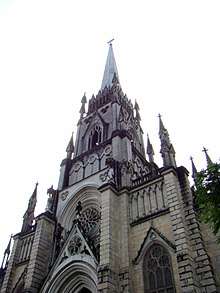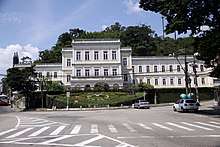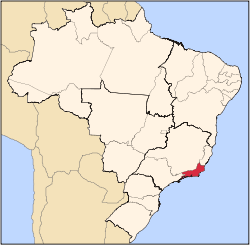Petrópolis
Petrópolis (Portuguese pronunciation: [peˈtɾɔpolis], [pɛˈtɾɔpolis], [pɛˈtɾɔpɔliɕ], [pɛˈtɾɔpuliɕ]), also known as The Imperial City, is a municipality in the Southeast Region of Brazil, inside the Rio de Janeiro state located 68 kilometres (42 mi) northeast of the Rio de Janeiro city. According to the 2010 National Brazilian Census, Petrópolis municipality had 305,917 inhabitants that year, up from 286,537 inhabitants at the last census. Besides being the largest and most populous city in the Fluminense Mountain Region, the city also has the largest GDP and HDI in the region. Petrópolis is considered the safest city in the state of Rio de Janeiro and the sixth safest city in Brazil, according to IPEA classification for medium and large cities.
Petrópolis | |
|---|---|
Municipality | |
| Município de Petrópolis Municipality of Petrópolis | |
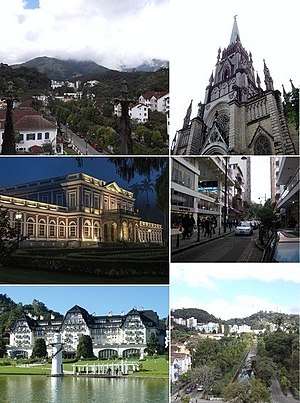 From upper left: skyline of downtown, city's Cathedral, Imperial Museum, 16 de Março street, Quitandinha Palace, and aerial view from the Cathedral. | |
 Flag  Seal | |
| Nickname(s): The Imperial City | |
| Motto(s): "Altiora Semper Petens" (Latin for "Always seeking higher things") | |
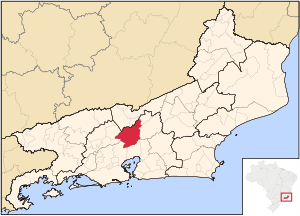 Location of Petrópolis in the state of Rio de Janeiro | |
 Petrópolis Location of Petrópolis in Brazil | |
| Coordinates: 22°30′18″S 43°10′44″W | |
| Country | |
| Region | Southeast |
| State | |
| Founded | 16 March 1843 |
| Government | |
| • Type | Mayor-council |
| • Mayor | Bernardo Rossi (PMDB) |
| • Vice Mayor | Albano Batista Filho (PMDB) |
| Area | |
| • Total | 795.798 km2 (307.259 sq mi) |
| Elevation | 838 m (2,749 ft) |
| Population (2015) | |
| • Total | 283,400 |
| • Rank | 90th |
| • Density | 384,42/km2 (99,560/sq mi) |
| Demonym(s) | Petropolitano |
| Time zone | UTC−3 (BRT) |
| Postal Code | 25680-000 |
| Area code(s) | +55 24 |
| Website | www.petropolis.rj.gov.br |
The town's name ("city of Peter") honors Pedro II, the last Emperor of Brazil, who is entombed there at the Cathedral of Saint Peter of Alcantara.[1] The city was the summer residence of the Brazilian Emperors and aristocrats in the 19th century, and was the official capital of the state of Rio de Janeiro during the First Brazilian Republic, between 1894 and 1902.[1]
There are projects to annex Petropolis again to the Metropolitan Region of Rio de Janeiro, because it is linked to the capital by political and economic ties, and contains one of the state's largest HDIs.[2]
History
Colonial period

Until the 18th century, the region was inhabited by the índios coroados (crowned Indians), which earned it the Portuguese name of "Sertão dos Índios Coroados". It was only with the discovery of gold in Minas Gerais and the consequent opening of the new way of the mines that passed through Petrópolis in that century that the region began to be occupied by non-Indians.[3] The town's origins can be traced to Bernardo Soares de Proença, who between 1722 and 1725 opened an alternative route between Rio de Janeiro and Minas Gerais, across the Serra da Estrela called "Caminho Novo das Minas" (New Road to Mines).
Imperial period
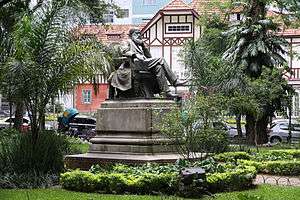
While traveling to Minas Gerais along this route in 1822, Emperor Pedro I found the region's climate pleasant, while staying at the farm of Correia, a Catholic priest. As the priest's sister and heiress refused to sell his property, the Emperor bought in 1830 the neighboring one, the Córrego Seco Farm. He had his Summer Palace built there, but never saw it finished, because he stepped down from the throne, on April 7, 1831.[4] Other Brazilian aristocrats eventually followed suit.
His son, Emperor Pedro II, on March 16, 1843, signed an imperial decree ordering the construction of a settlement (to be formed with the arrival of German immigrants) and the construction of the dreamy summer palace on his outlying lands, the cornerstone of which was settled by the Emperor in May 1845, and that was ready in 1847.[1] Conceived by Major Julius Friedrich Koeler, it is considered as the second projected city of Brazil (after Recife, designed during the Dutch period), being composed of an urban nucleus – the city (now the center), where the Imperial Palace, Public buildings, commerce and services.
From then on, during the summer, the city became the de facto capital of the Empire of Brazil, with the change of the whole court. Large numbers of inhabitants of the city of Rio de Janeiro also moved during the summer to Petropolis to escape the outbreaks of yellow fever. Emperor Pedro II ruled for 49 years and, in at least forty summers, remained in Petrópolis, possibly for up to five months. On 29 September 1857, the town was elevated to the status of a city. In 1861, the first Macadamized Highway in Brazil, Estrada União e Indústria, was inaugurated, connecting the city to the city of Juiz de Fora in Minas Gerais. In 1883, the railroad arrived at the city on the initiative of the Baron of Mauá. Also in 1877 the first telephone line of Brazil connecting his Summer Palace to his farm headquarters, which was also the first line outside the United States, was installed in the city.
Regardless of the time of year, it was in Petropolis that foreign diplomatic representatives lived for most of the imperial period.
Republican period
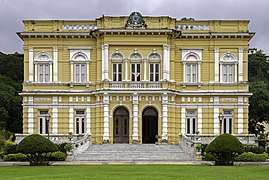
Even after the establishment of the Republic and the exile of the Imperial family in 1889, the city continued to play a significant role in Brazilian history. It was a frequent choice as summer residence for Presidents of the republic, who lodged at the Palácio Rio Negro (Black River Palace). The most frequent of them was Getúlio Vargas, whose stays, during Estado Novo, lasted up to three months. In the premises of the Quitandinha Palace, the declaration of war of the American countries to the Axis Powers was signed during World War II (1939–1945).
Between 1894 and 1902, the city was capital of the State of Rio de Janeiro, replacing Niterói, due to the two Navy Revolts. Also in this period, was chosen Hermogênio Silva, the only Deputy Governor of Rio de Janeiro whose political base was in Petrópolis. In 1897, the first cinema session took place in the city, with cinematographer showing of the Lumière brothers' first films. In 1903, the Treaty of Petrópolis, which gave Brazil the Acre territory, was signed between Brazil and Bolivia, at the residence of the Baron of Rio Branco.[5][6] The sanitarian Oswaldo Cruz was named its first mayor in 1916.
During the Brazilian military government in 1970s, there was a centre for torture, called the House of Death.[7]
In 1973 the remains of Isabel, Princess Imperial of Brazil (1846–1921) and her husband, the Count of Eu, were brought to be buried in the Imperial Mausoleum. The Princess received a funeral of Head of State with the presence of the most important leaders of the Republic and the Brazilian Imperial Family and was declared a public holiday.
Geography
Nestled among the forested hills of the Serra dos Órgãos, in the valley of the Quitandinha and Piabanha rivers, Petrópolis is a popular winter holiday spot. Besides the climate and surroundings, the main attraction is the former Summer Palace of the last Brazilian Emperor, which is now the Imperial Museum, specializing in Imperial history and memorabilia.
Petrópolis is home to the National Laboratory for Scientific Computing, a research unit of the Ministry of Science and Technology of the Brazilian Federal Government.
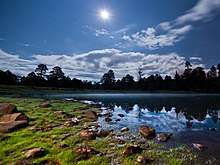
The municipality holds part of the Central Rio de Janeiro Atlantic Forest Mosaic of conservation units, created in 2006.[8]
The 16.7 hectares (41 acres) Petrópolis Municipal Nature Park is in the historical center of the city of Petrópolis.[9] It is part of the Petrópolis Environmental Protection Area and the Atlantic Forest Biosphere Reserve.[10] The municipality also contains the 530 hectares (1,300 acres) Pedra do Elefante Natural Monument.[11]
Climate
Petrópolis has a subtropical highland climate (Köppen climate classification: Cwa) caused by elevation with humid summers. The rainfall is approximately 2,400 mm (94 in) per annum.
The municipality contains part of the 26,260 hectares (64,900 acres) Tinguá Biological Reserve, a strictly protected Atlantic Forest conservation unit created in 1989.[12]
The temperature is mild. The annual average is around 19 °C (66 °F). In warmer months, the average temperature is 23 °C (73 °F) and the average of the coldest month is 15 °C (59 °F). According to the National Institute of Meteorology (pt: Instituto Nacional de Meteorologia), the lowest temperature recorded was −0.7 °C (30.7 °F) on August 2, 1955 and the highest temperature recorded was 36.6 °C (97.9 °F), on November 6, 2009.
| Climate data for Petrópolis | |||||||||||||
|---|---|---|---|---|---|---|---|---|---|---|---|---|---|
| Month | Jan | Feb | Mar | Apr | May | Jun | Jul | Aug | Sep | Oct | Nov | Dec | Year |
| Average high °C (°F) | 26.8 (80.2) |
27.5 (81.5) |
27.1 (80.8) |
25.7 (78.3) |
22.7 (72.9) |
22.3 (72.1) |
21.5 (70.7) |
23.2 (73.8) |
23.3 (73.9) |
25.1 (77.2) |
25.1 (77.2) |
26.1 (79.0) |
24.7 (76.5) |
| Average low °C (°F) | 17.5 (63.5) |
17.5 (63.5) |
17.1 (62.8) |
15.7 (60.3) |
13.1 (55.6) |
11.9 (53.4) |
11.3 (52.3) |
12.1 (53.8) |
13.3 (55.9) |
15.0 (59.0) |
15.9 (60.6) |
17.0 (62.6) |
14.8 (58.6) |
| Average rainfall mm (inches) | 311 (12.2) |
156 (6.1) |
149 (5.9) |
64 (2.5) |
39 (1.5) |
17 (0.7) |
29 (1.1) |
24 (0.9) |
51 (2.0) |
104 (4.1) |
188 (7.4) |
251 (9.9) |
1,383 (54.3) |
| Average rainy days (≥ 0.1 mm) | 18 | 13 | 13 | 7 | 6 | 3 | 4 | 4 | 7 | 9 | 14 | 17 | 115 |
| Average relative humidity (%) | 83 | 84 | 85 | 86 | 87 | 84 | 83 | 82 | 80 | 81 | 82 | 86 | 84 |
| Source: Rio 2016 web site[13] | |||||||||||||
Demography
Petrópolis lived a strong population growth in the late nineteenth century, which remained less significant throughout the twentieth century, having its population began to stagnate and then to contract (even if in a mild way) around the beginning 2000.[14] According to 2010 data, 52.3% (approximately 155 thousand people) of the population belong to the female sex and 48.7% (about 145 thousand people) to the male sex.
Religion
According to the 2012 census of IBGE, Petrópolis is composed by:[15]
- Roman Catholic Apostolic – 56.98%
- Protestants – 26.72%
- Kardecist Spiritists – 4.25%
- No Religion (Including Atheists, and Agnostics) – 9.32%
- Others – 2.73%
Ethnic composition
According to the 2010 demographic census, Petrópolis was formed by 186,642 whites (63.5%), 75,025 pardos (25.4%), 31,463 blacks (10.6%), 970 yellows (0.4%) and 281 indigenous people (0.1%).[16]
The main peoples to participate in the ethnic/cultural formation of Petrópolis were the Germans and the Portuguese (mainly from the region of the Azores). Other ethnic groups like Italian, French, English and Lebanese also had expressive participation in the formation of the city.[17][18][19]
City districts
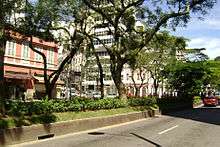
Petrópolis is divided into five districts, which are subdivided into smaller neighborhoods. These districts are subdivided into neighborhoods and / or urban and rural locations.
Petrópolis
- Downtown
- North zone: Quissamã, Retiro, Jardim Salvador, Itamarati (parte), Atílio Marotti, Quarteirão Brasileiro, among others.
- South zone: Valparaíso, Quitandinha, Duques, Taquara, Parque São Vicente, Coronel Veiga, Castelânea, Siméria, Duas Pontes, Ponte Fones, Quarteirão Suíço, Quarteirão Italiano, Independência, São Sebastião, Saldanha Marinho, Alto Independência, Mauá, among others.
- West zone: Bingen, Mosela, Duarte da Silveira, Capela, Castrioto, Pedras Brancas, Vila Militar, Rócio, Bataillard, Moinho Preto, Fazenda Inglesa, Quarteirão Ingelhein, Quarteirão Nassau, among others.
- East Zone: Morin, Alto da Serra, 24 de Maio, Vila Felipe, Vila Real, Campinho, Chácara Flora, Sargento Boening, Oswero Vilaça, Meio da Serra, among others.
Districts
- Cascatinha – Araras, Vale das Videiras, Bonsucesso, Carangola, Vila Manzini, Castelo São Manoel, Corrêas, Bairro da Glória, Itamarati, Estrada da Saudade, Nogueira, Samambaia, Jardim Salvador, Roseiral, Alcobacinha and Humberto Rovigatti.
- Itaipava – Madame Machado, Mangalarga, Vila Rica, Jardim Americano, Vale do Cuiabá, Benfica, Laginha, Gentio, Catubira, Ribeirão, Castelo, Reta, Sumidouro, Santa Mônica, Arranha-Céu, Parque Santa Maria, Parque dos Eucaliptos, Estrada das Arcas and centro de Itaipava
- Pedro do Rio – Secretário, Fagundes, Taquaril, Barra Mansa, among others.
- Posse – Brejal, Rio Bonito, Tremedeira, Granjas Raposo, Nossa Senhora de Fátima, Jacuba among others.
Economy
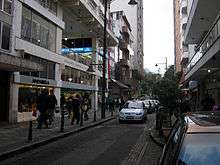
Petrópolis' economy is based on tourism, services and industry. It is the 2nd largest beer production centre in the country and the headquarters of major Brazilian brewery companies such as Grupo Petrópolis (which owns the beer brands Itaipava, Crystal, Lokal, Black Princess and Petra) and Bohemia, and also has a Brasil Kirin Factory.[20][21]
Other companies also have their headquarters in the city, such as the Mundo Verde network (Brazilian retailer of natural products) and the chocolate maker Katz. Currently the project is being developed for the Industrial District of Posse, which aims to encourage industries in the 5th district of the city. Petrópolis has the 9th largest GDP of the state of Rio de Janeiro, in front of cities such as Nova Friburgo and Teresópolis, and, in national scope, more than six state capitals, such as Aracaju, Palmas and Macapá.
The city's economy is still larger than entire states of the federation, such as Roraima and Acre.
Tourism
The high season of tourism in Petrópolis begins in July, with the beginning of Bauernfest, and the beginning of winter, which attracts tourists to the city by the cold weather. In 2014, some attractions increased more than 30%, compared to the same period of 2013, due to the FIFA World Cup Brazil 2014.
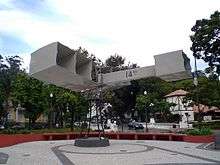
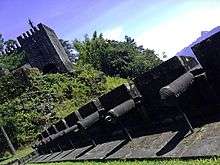
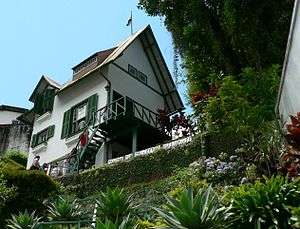
It is the city of the mountain region of Rio de Janeiro that receives more tourists per year. Petrópolis was the non-capital that progressed most in the Competitiveness Index of the National Tourism in 2014, prepared by the Ministry of Tourism. According to the developers, the city is among the 15 best placed in Brazil in the overall ranking of competitiveness in tourism.
The main attractions of the city are:
- Açu Hill (Serra dos Órgãos National Park)
- Casa Stefan Zweig
- Castle of the Baron of Itaipava, (currently under reformation)
- Crystal Palace
- District of Itaipava, containing many popular attractions such as the "orto" market, vilareijo and the municipal park located in the heart of the district.
- Fatima's Throne
- Grão-Pará Palace
- House of Ipiranga (“House of the Seven Mistakes")
- House of Joaquim Nabuco
- House of Princess Isabel
- House of Rui Barbosa
- House (chalet) of Santos-Dumont
- House of the Baron and Viscount of Arinos
- House of the Baron and Viscount of Mauá
- House of the Viscount of Caeté
- Imperial Museum of Brazil
- Monastery of the Virgin
- Petrópolis City Park
- Petrópolis Wax Museum
- Quitandinha Palace
- Rio Negro Palace
- Rural touristic tours of Taquaril, Brejal and Araras
- Saint Peter of Alcantara Cathedral (Cathedral of Petrópolis) with the Imperial Mausoleum
- Valparaíso (Gastronomic and Entertainment Center of Petrópolis)
- Bauernfest (Annual Festival in honor to the German immigrants)
Education
.jpg)
In the city, there are two public universities, the University of the State of Rio de Janeiro (UERJ), and the Fluminense Federal University (UFF), both of which have nationally recognized excellence levels, respectively, offering Architecture and Production Engineering courses. There is also in the city a unit of the Federal Center of Technological Education Celso Suckow of Fonseca (CEFET-RJ), with the courses of Degree in Physics, Bachelor in Tourism and Computer Engineering.[22][23][24]
In addition to these, the city has the Catholic University of Petrópolis, the Petrópolis Medical School, Arthur Sá Earp Neto College, Estácio de Sá University, FAETERJ – Faculty of Technological Education of the State of Rio de Janeiro (Faculdade Estadual do Rio de Janeiro), which offers courses in Information Technology and Communication, and private higher education institutions that offer several undergraduate courses and also postgraduate courses (lato sensu and stricto sensu).
The municipality houses one of the teaching centers of the Distance Learning Center of the State of Rio de Janeiro, a consortium formed by public institutions of higher education in the state of Rio de Janeiro. This consortium offers free undergraduate courses in Pedagogy, Mathematics, Biology and Public Safety. The National Laboratory of Scientific Computing offers free masters and doctorate courses in the areas of Computation, Mathematics, Biology, Physics and Engineering.
In the field of basic education, the municipal education network reached the goal of the IDEB for 2011 and had its mark above the averages of the state and the country.
Transport
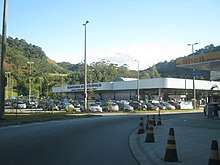
According to the IBGE census, in the year 2014 the total fleet of Petrópolis had 142,576 vehicles, approximately 1 vehicle for 2.1 inhabitants.[25]
Of these were: 96,384 automobiles; 21,133 motorcycles; 8,048 pickup trucks; 6,753 vans; 3,092 heavy trucks; 2,769 scooters; 1,289 utilities; 926 buses; 680 micro-buses; 290 tractor-trucks; And 1,232 other types of vehicles. The public transport in the city is made by several companies, being the greater one, Petrolta.[26]
The main public transport in Petrópolis is the bus alongside with taxis.
Culture
The culture of Petrópolis is directly linked to the imperial period of Brazil. Being nicknamed as Imperial City, the city has a large collection of theaters, museums, and palaces that refer to the period. In addition, much of the culture of the city was influenced by the immigration that participated in the formation of the identity of Petrópolis, where the German, Portuguese, Syrian, Lebanese and Italian groups stand out. Even today the city has the second largest festival of German culture in Brazil, the Bauernfest, only losing to the Oktoberfest in the south of the country. In addition, festivals are held every year that bring back the culture of other peoples, such as the Serra Serata, in honor of Italian immigration, and Bunka-Sai, a celebration of Japanese culture. The Cultural Foundation promotes every year (since 2009) the Maestro Guerra-Peixe de Cultura Prize, which honors the most outstanding artists and cultural agents during the year; The patron César Guerra-Peixe was an illustrious composer Petropolitan.
Architecture
The city has a unique architecture, such as the Palácio Quitandinha, the Petropolitan Academy of Letters, the House Museum of Santos Dumont, the Imperial Museum of Brazil, the Dom Pedro Theater, the Casa do Colono Museum and the Cathedral of Saint Peter of Alcantara. The palace is the main building of the so-called "historic center", where Koeler Avenue stands out, surrounded by mansions and palaces of the 19th century. The road is perpendicular to the facade of the Cathedral of Saint Peter of Alcantara and, in the other direction, the Ruy Barbosa Square and the facade of the Catholic University.
In the so-called "historic center", there are also buildings such as "Encantada" (summer house of Santos Dumont); The Crystal Palace; The Yellow Palace (City Council); The Rio Negro Palace, bordering the city hall (Sérgio Fadel Palace) and curious buildings, such as the "castelinho" of the self-proclaimed "Duke of Belfort", on the corner of Koeler and Ruy Barbosa Square, or the old house of the Rocha Miranda family, on Avenida Ipiranga – same address of another residence of the same family, in a sixties style. Modern lines are also present in the house of Lúcio Costa, in the neighborhood of Samambaia.
Theatres
Petrópolis has 2 theaters. The Teatro Dom Pedro, created in Art Deco style and inaugurated in 1933 by D'Angelo & Cia, is one of the largest in the state. The place was created with different styles, with mythological and futuristic references, making the theater considered an eclectic style, becoming a cultural and artistic reference for Petrópolis. The city also owns the Teatro Santa Cecília, built in 1955, located in Rua Aureliano Coutinho in the center of the city.
Museums

Petropolis has great tradition as an imperial city. For this reason, today it owns one of the most important museums of history of Brazil, the Imperial Museum. Built between 1845 and 1862 as the summer Palace of the Imperial Family, it has a collection of pieces linked to the Brazilian monarchy, including furniture, documents, works of art and personal objects belonging to the Imperial Family. The Palace turned museum in 1943 by decree of the then president Getúlio Vargas. In addition, the city has the Petrópolis Wax Museum, Casa Santos Dumont Museum, Casa do Colono Museum, Princess Isabel House and Rio Negro Palace, all located in the city center.
With more than 321.000 visitors, the Imperial Museum in Petrópolis was the most visited museum in Brazil in 2016, according to data from the Brazilian Institute of Museums (Ibram) of the Ministry of Culture.[27]
Festivals
The Petropolis culture is directly linked to German immigration.[28] Since 1989, Bauernfest, a typical feast in honor of German immigrants, is held every year. The festival in 2012 lasted 11 days, had the participation of 368.000 visitors and raised R$55 million. The festival welcomes foreign tourists from all over Brazil, especially from the city of Rio de Janeiro. It is the most influential party of the city and includes competitions of chope the meter, presentations, typical cuisine, exhibition of chocolates, among other attractions.[29][30]
The city also holds the Serra Serata, an annual festival that celebrates immigration and Italian culture.[31]
Petrópolis also hosts the Winter Festival, promoted by SESC, with several attractions for this period of the year, which usually happens in the Quitandinha Palace. The festival is already traditional in the cities of Petrópolis, Nova Friburgo and Teresópolis. In 2014 was held the 13th edition, counting on concerts, theatrical presentations and cultural events.[32][33][34]
The city also hosts Bunka-Sai, the annual festival of Japanese culture, which had its first edition in 2009. It has cultural presentations, in addition to the Japanese gastronomic festival.[35][36]
Carnival
In 2013, the carnival of the city was canceled, for the application of the funds in the approximate amount of R$1 million, previously used in the parades, in the area of health, thus making Petrópolis a refuge of Cariocas of the Carnival. The decision was made during a meeting between the mayor and the Foundation for Culture and Tourism.[37][38][39]
Media
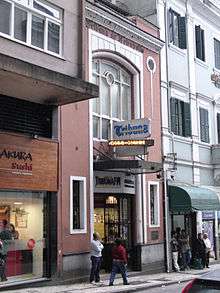
The main television station transmitting news related to the city is InterTV Serra + Mar, as well as other local broadcasters such as SBT Rio and Band Rio, which present news from the mountain region of Rio de Janeiro, mainly related to Petrópolis and Nova Friburgo. The city also has local television networks with a certain influence: Rede Petrópolis de Televisão, TV Vila Imperial and TV Cidade de Petrópolis, with headquarters located in the center.[40][41]
The main written newspaper of the city is the Tribuna de Petrópolis, one of the oldest in the country, created in 1909, published from Tuesday to Sunday, whose headquarters are in the center. Also worthy of note is the newspaper Diário de Petrópolis, published daily, of great influence in the city.[42][43]
The main and most listened radio stations with headquarters in Petrópolis are Radio Tribuna FM (88.5 MHz), Radio UCP (106.3 MHz), Radio Supernova FM (98.7 MHz) and Radio Imperial (1550 AM). In addition, radio stations based in the city of Rio de Janeiro, such as the MIX FM Rio Radio, which already owned an exclusive domain of Radio MIX in Petrópolis, which was later purchased by Rádio UCP, are also very much heard.[44][45][46]
In recent years, the internet has proved to be one of the main media for news. In Petrópolis, the main ones are the G1 of the Serrana Region, the online portal of the Tribuna de Petrópolis, and the Diário de Petrópolis, besides the site Acontece in Petrópolis and the portal with live broadcast of TVC 16 (TV Cidade de Petrópolis) . Also worth mentioning is the online portal of the RPT (Rede Petrópolis de Televisão).[47][48][49]
Notable people
- Dom Pedro de Alcântara, Prince of Grão-Pará
- Prince Luís of Orléans-Braganza
- Rafael da Silva, Olympique Lyonnais footballer
- Michel de Souza, operatic baritone, born in Petrópolis[51]
- Guilherme Fontes, Brazilian Actor
- Edwin V. Morgan, United States Ambassador to Brazil 1912–1933
- Fiorella Mattheis, Brazilian Actress
- Phill Joannes, Fashion photographer and visual artist
- Peter Brian Medawar, Winner of the Nobel Prize in Physiology or Medicine, among other awards.
- Camila Morgado, Brazilian Actress
- Rodrigo Santoro, Actor who has appeared in many successful movies, including 300, What to Expect When You're Expecting, among others
- Magda Tagliaferro, Brazilian Pianist
- Stefan Zweig, Austrian author, lived in Petropolis from 1940 until his suicide in the same city on February 23, 1942.
- Raphael Rabello, virtuoso Brazilian guitarist and composer.
- Elizabeth Bishop, American poet and short-story writer, lived partly in Petropolis for 17 years (1944–61) with Lota de Macedo Soares, architect and landscape designer.[52]
- Cristiane Brasil, Brazilian politician was born in Petropolis
Gallery
 Landscape of Petrópolis (Woodland with a Creek), unknown date.
Landscape of Petrópolis (Woodland with a Creek), unknown date. Baron of Rio Branco's house
Baron of Rio Branco's house Landscape of Petrópolis, unknown date.
Landscape of Petrópolis, unknown date.- Imperial Palace of Petrópolis, circa 1855.
 City entrance
City entrance Araucaria angustifolia, Brazilian pine
Araucaria angustifolia, Brazilian pine The railway engine 11 was used on the railway line that, during the period 1883–1964, ran between Rio de Janeiro and Petrópolis.
The railway engine 11 was used on the railway line that, during the period 1883–1964, ran between Rio de Janeiro and Petrópolis. Quitandinha Lake
Quitandinha Lake- Quitandinha Palace in autumn
- House of Ipiranga (“House of the Seven Mistakes")
 Monument to Emperor Pedro II in the garden of the square with his name.
Monument to Emperor Pedro II in the garden of the square with his name.
 Statue of Pedro II in the Imperial Museum
Statue of Pedro II in the Imperial Museum- Landscape of Petrópolis, in front of the Imperial Museum
 Palácio Amarelo (Yellow Palace), The City Council of Petrópolis
Palácio Amarelo (Yellow Palace), The City Council of Petrópolis- Crystal Palace
 Bench in center of Petrópolis
Bench in center of Petrópolis
- Petropolis' Mountains
 Vale Imperial Residence
Vale Imperial Residence City centre
City centre Rua do Imperador (Emperor Street)
Rua do Imperador (Emperor Street)- View from cathedral tower
 Irmãos D'Ângelo Street
Irmãos D'Ângelo Street Christian Church
Christian Church- Obelisk
.jpg) Stained glass windows of Petrópolis Cathedral
Stained glass windows of Petrópolis Cathedral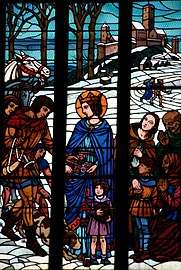 Stained glass windows of Petrópolis Cathedral
Stained glass windows of Petrópolis Cathedral- Liberdade Square

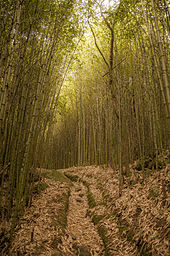 Trail at the "Serra dos Órgãos" National Park
Trail at the "Serra dos Órgãos" National Park
References
- "Emperor Street". World Digital Library. 1860–1870. Retrieved 2013-08-24.
- "Projeto de Lei Complementar n.º 13/2012 que insere, novamente, Petrópolis na Região Metropolitana do Rio. ALERJ".
- "Prefeitura de Petrópolis". Archived from the original on 2012-10-23.
- Home
- http://www.ideias.org.br/, Instituto IDEIAS -. "Petrópolis/RJ – Informações Turísticas – Casa do Barão do Rio Branco". destinopetropolis.com.br (in Portuguese). Archived from the original on 2017-04-05. Retrieved 2017-04-05.
- "15 Coisas que você não sabia sobre Petrópolis". Castelo de Itaipava Hotel (in Portuguese). 2016-08-20. Archived from the original on 2017-04-05. Retrieved 2017-04-05.
- Torturerte politiske fanger i Brasil, nå er han funnet drept
- Costa, Cláudia; Lamas, Ivana; Fernandes, Rosan (December 2010), Planejamento Estratégico do Mosaico Central Fluminense (PDF) (in Portuguese), Reserva da Biosfera da Mata Atlântica, p. 13, retrieved 2016-10-02
- Parque Natural Municipal de Petrópolis (in Portuguese), Secretaria do Meio Ambiente e Desenvolvimento Sustentável RJ, retrieved 2016-10-04
- Parque Natural Municipal de Petrópolis (in Portuguese), Instituto IDEIAS, archived from the original on 2016-10-06, retrieved 2016-10-04
- Unidades de Conservação da Natureza no Município de Petrópolis (in Portuguese), Município de Petrópolis, retrieved 2016-10-07
- Unidade de Conservação: Reserva Biológica do Tinguá (in Portuguese), MMA: Ministério do Meio Ambiente, retrieved 2016-04-18
- "Climatological Information for Petrópolis, Brazil". Rio 2016. Archived from the original on December 2, 2013. Retrieved November 24, 2013.
- "Dados de população".
- "Censo Demográfico IBGE". Archived from the original on 2016-03-07. Retrieved 2019-01-28.
- "Censo demográfico IBGE, por composição étnica". Instituto brasileiro de Geografia, e Estatística. Archived from the original on 2016-01-19.
- "Colonização de Petrópolis". Archived from the original on 2014-12-29.
- "Colonos da cidade".
- "Colonização Alemã".
- http://www.tribunadepetropolis.net/Tribuna/index.php/cidade/8308-uerj-petropolis-deve-abrir-selecao-de-alunos-em-2014.html
- "Novo! Engenharia de Produção (Petrópolis) – divulgado Edital Suplementar | Universidade Federal Fluminense". www.uff.br. Retrieved 2015-11-22.
- "Frota total de veículos, IBGE 2014". Archived from the original on 2016-07-02. Retrieved 2019-01-28.
- "Empresas de ônibus da cidade, Prefeitura Municipal". Archived from the original on 2018-04-23. Retrieved 2019-01-28.
- "números – Portal do Instituto Brasileiro de Museus". www.museus.gov.br. Retrieved 2017-02-02.
- Antônio Eugênio Taulois (February 2007). "História de Petrópolis". Archived from the original on 2014-10-21. Retrieved 2014-11-25.
- "Bauernfest".
- "Festivais".
- "Prefeitura de Petrópolis – Serra Serata" (PDF). Archived from the original (PDF) on 2016-10-10.
- "G1 – Festival de Inverno".
- "Festival de Inverno – Apresentações".
- "Festival de Inverno".
- "Festival Bunka-Sai".
- "Bunka-Sai". Archived from the original on 2017-08-03. Retrieved 2017-08-02.
- "Archived copy". Archived from the original on 2014-02-03. Retrieved 2017-08-02.CS1 maint: archived copy as title (link)
- "InterTV". Archived from the original on 2013-08-12.
- "RPT – Rede Petrópolis de Televisão".
- "Tribuna de Petrópolis".
- "Diário de Petrópolis".
- "Rádio em Petrópolis".
- "Rádio em Petrópolis".
- "Rádio MIX Rio".
- "G1 de Petrópolis".
- "RPT".
- "Petrópolis News".
- "Lei municipal 3764/1990".
- "Michel de Souza". www.roh.org.uk. Royal Opera House. Retrieved 26 February 2014.
- https://www.poetryfoundation.org/poems-and-poets/poets/detail/elizabeth-bishop
External links
![]()
![]()
- Petrópolis City Hall (in Portuguese)
